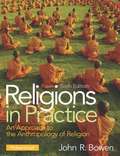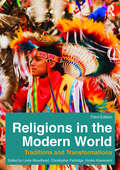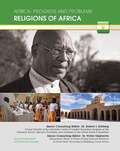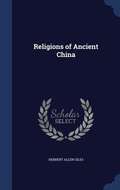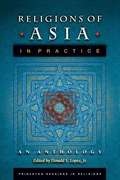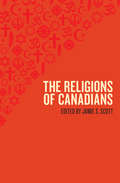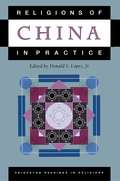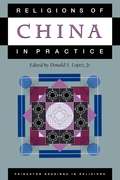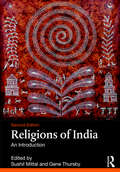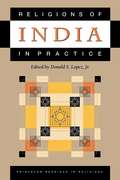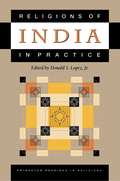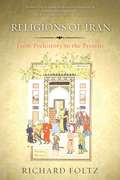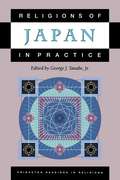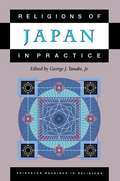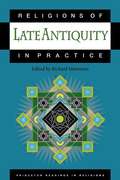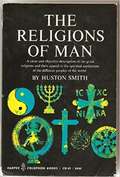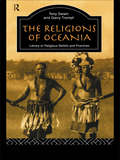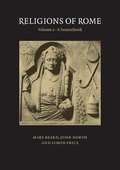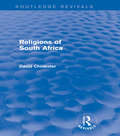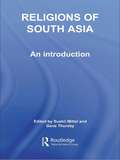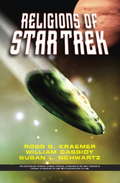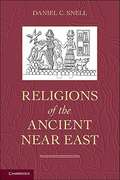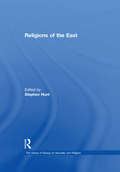- Table View
- List View
Religions in Practice (Sixth Edition)
by John R. BowenExamines religious practices from an anthropological perspective, Religions in Practice, 6/e, offers an issues-oriented perspective on everyday religious behaviors - prayer, sacrifice, initiation, healing, etc. - by focusing on such topics as transnationalism, gender, and religious laws. The text examines a full spectrum of religions, from small-scale societies to major, established religions. The in-depth treatment of Islam, Hinduism, and Christianity is particularly noteworthy and easily supplemented with field projects directly related to the text. MySearchLab is a part of the Bowen program. Research and writing tools, including access to academic journals, help students explore religion in even greater depth. To provide students with flexibility, students can download the eText to a tablet using the free Pearson eText app. NOTE: MySearchLab does not come automatically packaged with this text. To purchase the text with MySearchLab, order the package ISBN: 0205961045 / 9780205961047 Religions in Practice Plus MySearchLab with Pearson eText -- Access Card Package Package consists of: 0205239927 / 9780205239924 MySearchLab with Pearson eText -- Valuepack Access Card 0205917666 / 9780205917662 Religions in Practice
Religions in the Modern World: Traditions and Transformations
by Linda Woodhead Christopher Partridge Hiroko KawanamiReligions in the Modern World: Traditions and Transformations, Third Edition is the ideal textbook for those coming to the study of religion for the first time, as well as for those who wish to keep up-to-date with the latest perspectives in the field. This third edition contains new and upgraded pedagogic features, including chapter summaries, key terms and definitions, and questions for reflection and discussion. The first part of the book considers the history and modern practices of the main religious traditions of the world, while the second analyzes trends from secularization to the rise of new spiritualities. Comprehensive and fully international in coverage, it is accessibly written by practicing and specialist teachers.
Religions of Africa (Africa: Progress and Problems)
by Lora FriedenthalWhile African religions are as diverse as the continent itself, most Africans can be placed in one of three groups: followers of traditional religions, Islam, or Christianity. Until the 20th century, religion was rarely a primary source of conflict. However, in recent years Muslim-Christian tensions have contributed to unrest in such nations as Nigeria, Sudan, and Tanzania. This book is intended as an introduction to the practice of religion in Africa today. It provides a brief history of religious development in Africa, discusses the common religious practices in various regions of the continent, and explores the role of religion in current African conflicts.
Religions of Ancient China
by Herbert Allen GilesThis work has been selected by scholars as being culturally important, and is part of the knowledge base of civilization as we know it. This work was reproduced from the original artifact, and remains as true to the original work as possible. Therefore, you will see the original copyright references, library stamps (as most of these works have been housed in our most important libraries around the world), and other notations in the work. This work is in the public domain in the United States of America, and possibly other nations. Within the United States, you may freely copy and distribute this work, as no entity (individual or corporate) has a copyright on the body of the work. As a reproduction of a historical artifact, this work may contain missing or blurred pages, poor pictures, errant marks, etc. Scholars believe, and we concur, that this work is important enough to be preserved, reproduced, and made generally available to the public. We appreciate your support of the preservation process, and thank you for being an important part of keeping this knowledge alive and relevant.
Religions of Asia in Practice: An Anthology
by Donald S. LopezThe acclaimed volumes of Princeton Readings in Religions present the remarkable range of all that is encompassed in the practice of religions, across the centuries and across the world. Religions of Asia in Practice: An Anthology brings together into a single volume the most important and fascinating selections from the volumes on Buddhism, India, China, Tibet, and Japan to give an overview of how religions have been lived by both ordinary and extraordinary people throughout the continent of Asia. These materials--many of which had never before been translated into any Western language--include ritual manuals, hagiographical and autobiographical writings, popular commentaries, instructions to children, poetry, and folktales. Each is preceded by a substantial introduction in which the translator discusses the text's history and influence and guides the reader through points of potential difficulty and particular interest. The volume includes, in addition, clear and compelling introductions to each of the major traditions. Religions of Asia in Practice: An Anthology offers a fascinating look at the spectrum of religious practices in Asia over almost three millennia. As such, it is ideally suited for use as a textbook in courses on world or Eastern religions as well as for the general reader.
The Religions of Canadians
by Jamie S ScottThe Religions of Canadians is a book about religions and the making of Canada. Drawing on the expert knowledge and personal insights of scholars in history, the social sciences, and the phenomenology of religion, separate chapters introduce the beliefs and practices of nine religious traditions, some mainstream, some less familiar.The opening chapter explores how Aboriginal Canadian traditions continue to thrive after centuries of oppression. Subsequent chapters follow in the footsteps of Catholic and Protestant Christians, Jews, Muslims, Hindus, Buddhists, Sikhs, and Baha'is as they have made their way to Canada, and reveal how different immigrant communities have adapted their rich religious heritages to a new life in a new land. Each chapter is divided into five sections: an introduction; a succinct overview of the tradition; its passage to and transformation in Canada; a close study of contemporary Canadian communities; and an afterword suggesting possibilities for future research. Chapters conclude with a list of important terms and dates, related websites, a concise bibliography of further readings, and key questions for reflection.The Religions of Canadians is a timely and unique contribution to the field, introducing readers to the religions of the world while simultaneously building an overall picture of the development of Canada's multicultural, pluralist society.
Religions of China in Practice (Princeton Readings in Religions #37)
by Donald S. Lopez, ]r., EditorThis third volume of Princeton Readings in Religions demonstrates that the "three religions" of China--Confucianism, Daoism, and Buddhism (with a fourth, folk religion, sometimes added)--are not mutually exclusive: they overlap and interact with each other in a rich variety of ways. The volume also illustrates some of the many interactions between Han culture and the cultures designated by the current government as "minorities." Selections from minority cultures here, for instance, are the folktale of Ny Dan the Manchu Shamaness and a funeral chant of the Yi nationality collected by local researchers in the early 1980s. Each of the forty unusual selections, from ancient oracle bones to stirring accounts of mystic visions, is preceded by a substantial introduction. As with the other volumes, most of the selections here have never been translated before. Stephen Teiser provides a general introduction in which the major themes and categories of the religions of China are analyzed. The book represents an attempt to move from one conception of the "Chinese spirit" to a picture of many spirits, including a Laozi who acquires magical powers and eventually ascends to heaven in broad daylight; the white-robed Guanyin, one of the most beloved Buddhist deities in China; and the burning-mouth hungry ghost. The book concludes with a section on "earthly conduct."
Religions of China in Practice
by Donald S. LopezThis third volume of Princeton Readings in Religions demonstrates that the "three religions" of China--Confucianism, Daoism, and Buddhism (with a fourth, folk religion, sometimes added)--are not mutually exclusive: they overlap and interact with each other in a rich variety of ways. The volume also illustrates some of the many interactions between Han culture and the cultures designated by the current government as "minorities. " Selections from minority cultures here, for instance, are the folktale of Ny Dan the Manchu Shamaness and a funeral chant of the Yi nationality collected by local researchers in the early 1980s. Each of the forty unusual selections, from ancient oracle bones to stirring accounts of mystic visions, is preceded by a substantial introduction. As with the other volumes, most of the selections here have never been translated before. Stephen Teiser provides a general introduction in which the major themes and categories of the religions of China are analyzed. The book represents an attempt to move from one conception of the "Chinese spirit" to a picture of many spirits, including a Laozi who acquires magical powers and eventually ascends to heaven in broad daylight; the white-robed Guanyin, one of the most beloved Buddhist deities in China; and the burning-mouth hungry ghost. The book concludes with a section on "earthly conduct. "
Religions of India: An Introduction
by Sushil Mittal Gene ThursbyIndia is a highly diverse country, home to a wide array of languages, religions, and cultural traditions. Analyzing the dynamic religious traditions of this democratic nation sheds light on the complex evolution from India’s past to today’s modern culture. Written by leading experts in the field, Religions of India provides students with an introduction to India’s vibrant religious faiths. To understand its heritage and core values, the beginning chapters introduce the indigenous Dharmic traditions of Hinduism, Jainism, Buddhism, and Sikhism, while the later chapters examine the outside influences of Zoroastrianism, Judaism, Christianity, and Islam. These chapters are designed for cross-religious comparison, with the history, practices, values, and worldviews of each belief system explained. The final chapter helps students relate what they have learnt to religious theory, preparing the way for future study. This thoroughly revised second edition combines solid scholarship with clear and lively writing to provide students with an accessible and comprehensive introduction to religion in India. This is the ideal textbook for students approaching religion in Asia, South Asia, or India for the first time. Features to aid study include: discussion questions at the end of each chapter, images, a glossary, suggestions for further reading, and an Companion Website with additional links for students to further their study.
Religions of India in Practice
by Donald S. LopezThis volume is organized thematically in order to suggest the interactions, intersections, and confluences in the religious practices of India.
Religions of India in Practice (Princeton Readings in Religions)
by Donald S. LopezThe inaugural volume of Princeton Readings in Religions brings together the work of thirty scholars of the religions of India in a new anthology designed to reshape the ways in which the religious traditions of India are understood. The book contains translations of forty-five works, most of which have never before been available in a Western language. Many of these highlight types of discourse (especially ritual manuals, folktales, and oral narratives) and voices (vernacular, esoteric, domestic, and female) that have not been sufficiently represented in previous anthologies and standard accounts of Indian religions. The selections are drawn from ancient texts, medieval manuscripts, modern pamphlets, and contemporary fieldwork in rural and urban India. They represent every region in South Asia and include Hindu, Buddhist, Jain, Sikh, and Muslim materials. Some are written texts reflecting elite concerns, while others are transcriptions of oral narratives told by nonliterate peasants. Some texts are addressed to a public and pan-Indian audience, others to a limited coterie of initiates in an esoteric sect, and still others are intended for a few women gathered in the courtyard for a household ceremony. The editor has reinforced this diversity by arranging the selections within several overarching themes and categories of discourse (hymns, rituals, narratives, and religious interactions), and encourages us to make our own connections.
Religions of Iran: From Prehistory to the Present
by Richard FoltzAlthough today associated exclusively with Islam, Iran has in fact played an unparalleled role within all the world religions, injecting Iranian ideas into the Jewish, Buddhist, Christian, and Manichaean traditions of the merchants who passed along the Silk Road. This vivid and surprising work explores the manner in which Persian culture has interacted with and transformed each world faith, from the migration of the Israelites to Iran thousands of years ago to the influence of Iranian notions on Mahayana Buddhism and Christianity. Foltz considers Iran's role in shaping the Muslim world, not only in the Middle East but also in South Asia in an evocative and informative journey through the spiritual heritage of an ancient and influential region.
Religions of Japan in Practice (Princeton Readings In Religions Ser.)
by George J. TanabeThe forty-five chapters in this anthology have no apparent master by which they may be ordered. This is, in part, by deliberate design, the attempt here being to present Japanese religions in their complex diversity rather than as neatly ordered systems of thought.
Religions of Japan in Practice (Princeton Readings in Religions #8)
by George J. TonabeThis anthology reflects a range of Japanese religions in their complex, sometimes conflicting, diversity. In the tradition of the Princeton Readings in Religions series, the collection presents documents (legends and miracle tales, hagiographies, ritual prayers and ceremonies, sermons, reform treatises, doctrinal tracts, historical and ethnographic writings), most of which have been translated for the first time here, that serve to illuminate the mosaic of Japanese religions in practice. George Tanabe provides a lucid introduction to the "patterned confusion" of Japan's religious practices. He has ordered the anthology's forty-five readings under the categories of "Ethical Practices," "Ritual Practices," and "Institutional Practices," moving beyond the traditional classifications of chronology, religious traditions (Shinto, Confucianism, Buddhism, etc.), and sects, and illuminating the actual orientation of people who engage in religious practices. Within the anthology's three broad categories, subdivisions address the topics of social values, clerical and lay precepts, gods, spirits, rituals of realization, faith, court and emperor, sectarian founders, wizards, and heroes, orthopraxis and orthodoxy, and special places. Dating from the eighth through the twentieth centuries, the documents are revealed to be open to various and evolving interpretations, their meanings dependent not only on how they are placed in context but also on how individual researchers read them. Each text is preceded by an introductory explanation of the text's essence, written by its translator. Instructors and students will find these explications useful starting points for their encounters with the varied worlds of practice within which the texts interact with readers and changing contexts. Religions of Japan in Practice is a compendium of relationships between great minds and ordinary people, abstruse theories and mundane acts, natural and supernatural powers, altruism and self-interest, disappointment and hope, quiescence and war. It is an indispensable sourcebook for scholars, students, and general readers seeking engagement with the fertile "ordered disorder" of religious practice in Japan.
Religions Of Late Antiquity In Practice
by Richard ValantasisThis is an unprecedented collection of nearly seventy Late Antique primary religious texts. These texts--all in new English translation and many appearing in English for the first time--represent every major religious current from the late first century until the rise of Islam. Produced through the efforts of thirty-six leading scholars in the field, they constitute a comprehensive view of religious practice in Late Antiquity. Religious life and performance during this period comprised diverse, often unusual practices. Philosophical ascent, magic, legal pronouncement, hymnography, dietary and sexual restriction, and rhetoric were all part of this deeply fascinating world. Religious and political identity often intertwined, as reflected in the Roman persecution of Christians. And a fluid boundary between religion and superstition was contested in daily life. Many practices, including ascetic training, crossed religious boundaries. Others, such as "incubation" at specific temples and certain divination rites, were distinctive practices of individual groups and orders. Intrinsically interesting, the practice of religion in the Late Antique also edifies modern-day religious life. As this volume shows, the origins of the contemporary Western religious terrain can be gleaned in this period. Rabbinic Judaism flourished and spread. Christianity developed still-important theological categories and structures. And even movements that did not survive intact--such as Neoplatonism and the once-powerful Manichaean churches--continue to influence religion today. This rich sourcebook includes discussions of asceticism, religious organization, ritual, martyrdom, religion's social implications, law, and theology. Its unique emphasis on practice and its inclusion of texts translated from lesser-known languages advance the study of religious history in several directions. A strong interdisciplinary orientation will reward scholars and students of religion, theology, gender studies, classical literatures, and history. Each text is accompanied by an introduction and a bibliography for further reading and research, making the book appropriate for use in any university or seminary classroom.
The Religions of Man
by Huston SmithNot a history or a critique, this is a unique study of all the world's great religions: Hinduism, Buddhism, Confuciansim, Taoism, Islam, Judaism, and Christianity.
The Religions of Oceania (The Library of Religious Beliefs and Practices)
by Garry TrompfMore than a quarter of the world's religions are to be found in the regions of Australia, Melanesia, Micronesia and Polynesia, together called Oceania. The Religions of Oceania is the first book to bring together up-to-date information on the great and changing variety of traditional religions in the Pacific zone. The book also deals with indigenous Christianity and its wide influence across the region, and includes new religious movements generated by the responses of indigenous peoples to colonists and missionaries, the best known of these being the `Cargo Cults' of Melanesia. The authors present a thorough and accessible examination of the fascinating diversity of religious practices in the area, analysing new religious developments, and provideing clear interpretative tools and a mine of information to help the student better understand the world's most complex ethnologic tapestry.
Religions of Rome: A Sourcebook (Volume #2)
by Mary Beard John North Simon PriceThe book presents a wide range of documents illustrating religious life in the Roman world - from the foundations of the city in the eighth century BC to the Christian capital more than a thousand years later. Each document is given a full introduction, explanatory notes and bibliography, and acts as a starting point for further discussion. Judaism and Christianity are given full coverage, as important elements in the religious world of the Roman Empire.
Religions of Rome Volume 1
by Mary Beard John North Simon PriceThis book offers a radical new survey of more than a thousand years of religious life in Rome, from the foundation of the city to its rise to world empire and its conversion to Christianity. It sets religion in its full cultural context, between the primitive hamlet of the eighth century BC and the cosmopolitan, multicultural society of the first centuries of the Christian era.
Religions of South Africa (Routledge Revivals)
by David ChidesterFirst published in 1992, this title explores the religious diversity of South Africa, organizing it into a single coherent narrative and providing the first comparative study and introduction to the topic. David Chidester emphasizes the fact that the complex distinctive character of South African religious life has taken shape with a particular economic, social and political context, and pays special attention to the creativity of people who have suffered under conquest, colonialism and apartheid. With an overview of African traditional religion, Christian missions, and African innovations during the nineteenth century, this reissue will be of great value to students of religious studies, South African history, anthropology, sociology, and political studies.
Religions of South Asia: An Introduction
by Sushil Mittal Gene ThursbySouth Asia is home to many of the world's most vibrant religious faiths. It is also one of the most dynamic and historically rich regions on earth, where changing political and social structures have caused religions to interact and hybridise in unique ways. This textbook introduces the contemporary religions of South Asia, from the indigenous religions such as the Hindu, Jain, Buddhist and Sikh traditions, to incoming influences such as Christianity, Judaism and Islam. In ten chapters, it surveys the nine leading belief systems of South Asia and explains their history, practices, values and worldviews. A final chapter helps students relate what they have learnt to religious theory, paving the way for future study. Written by leading experts, Religions of South Asia combines solid scholarship with clear and lively writing to provide students with an accessible and comprehensive introduction. All chapters are specially designed to aid cross-religious comparison, following a standard format covering set topics and issues; the book reveals to students the core principles of each faith, compares it to neighbouring traditions, and its particular place in South Asian history and society. It is a perfect resource for all students of South Asia's diverse and fascinating faiths.
Religions Of Star Trek
by Ross Kraemer William Cassidy Susan L SchwartzIs there a God? What evil lurks beyond the stars? Can science save one’s soul? Profound questions like these have consumed human thought over the ages; they also inspired the original creators of the Star Trek canon of TV series and films. Religions of Star Trek tackles these challenging questions head-on in a remarkable look at one of sci-fi’s great success stories. Analyzing more than three decades of screen adventure, the authors depict a Star Trek transformed, corresponding to the resurgence of religion in American public discourse. The authors identify the many religious characters in Star Trek, tracing the roots of scientific humanism to more contemporary aspects of religion and spirituality. Through it all, the creators’ visionary outlook remains constant: a humanistic faith in free will and the salvific nature of dispassionate scientific inquiry. This book was not prepared, licensed, approved, or endorsed by any entity involved in creating or producing the Star Trek television series or films.
Religions of the Ancient Near East
by Daniel C. SnellThis book is a history of religious life in the Ancient Near East from the beginnings of agriculture to Alexander the Great's invasion in the 300s BCE. Daniel C. Snell traces key developments in the history, daily life and religious beliefs of the people of Ancient Mesopotamia, Egypt, Israel and Iran. His research investigates the influence of those ideas on the West, with particular emphasis on how religious ideas from this historical and cultural milieu still influence the way modern cultures and religions view the world. Designed to be accessible to students and readers with no prior knowledge of the period, the book uses fictional vignettes to add interest to its material, which is based on careful study of archaeological remains and preserved texts. The book will provide a thoughtful summary of the Ancient Near East and includes a comprehensive bibliography to guide readers in further study of related topics.
Religions of the East (The Library of Essays on Sexuality and Religion)
by Stephen HuntUnder the rubric of 'Religions of the East', which includes Buddhism, Hinduism, Sikhism, Janiism and a myriad of Chinese religio-philosophies, are a vast range of views concerning human sexuality. These contrasting attitudes are mapped through this volume on Religions of the East in The Library of Essays on Sexuality and Religion series. Part 1 presents previously-published articles that explore several Eastern Religions in the way they construct sexuality through expressions of their pertinent holy writings and belief systems, as applied in differing historical and cultural contexts. Part 2 takes sexual renunciation and asceticism as its focus through the traditions of Hinduism, Jainism and the Chinese religious systems. Part 3 explores the connection between sexuality, gender and sexuality in Hindu and Buddhist customs in varied social settings. The final part of the volume includes articles examining Eastern religions in their attitudes towards sexual 'variants' including bi-sexuality, trans-sexuality and contested sexual categories.
